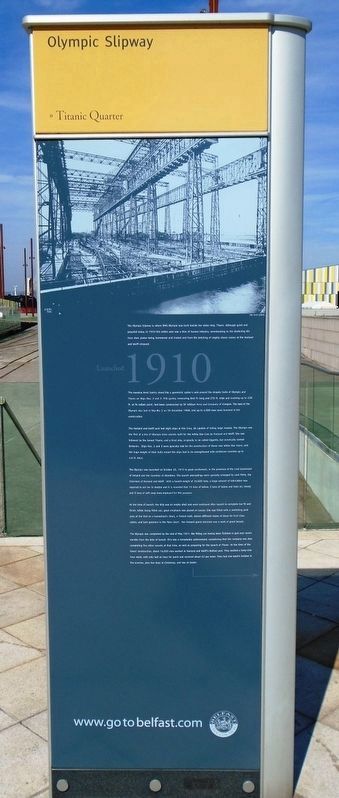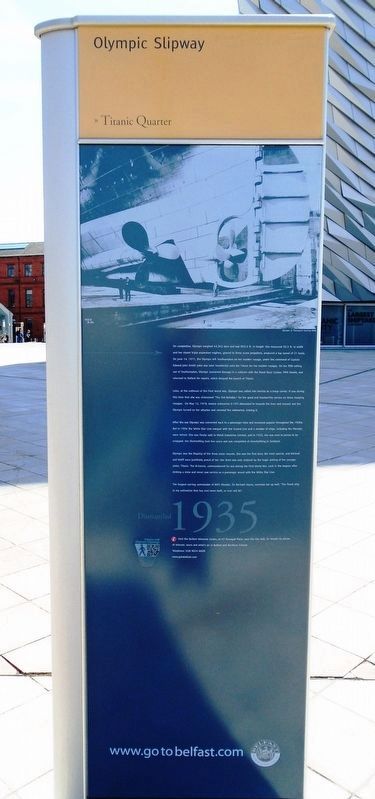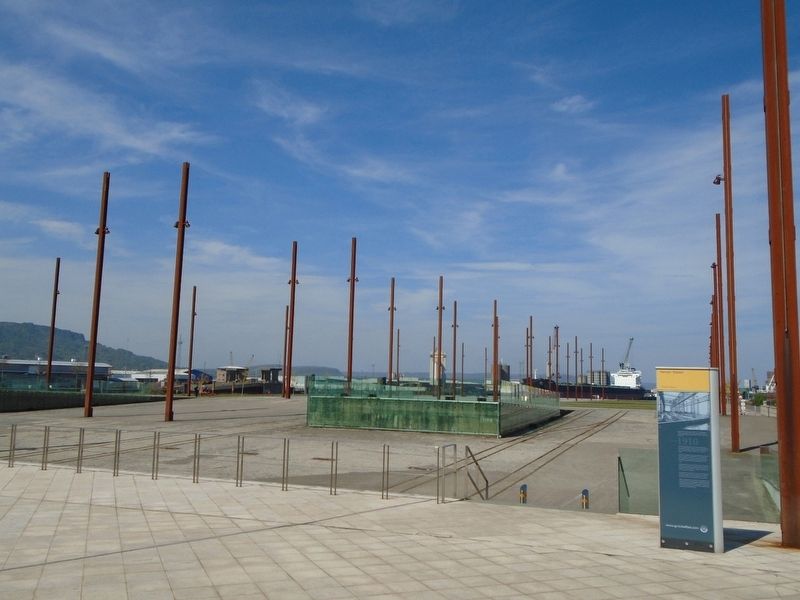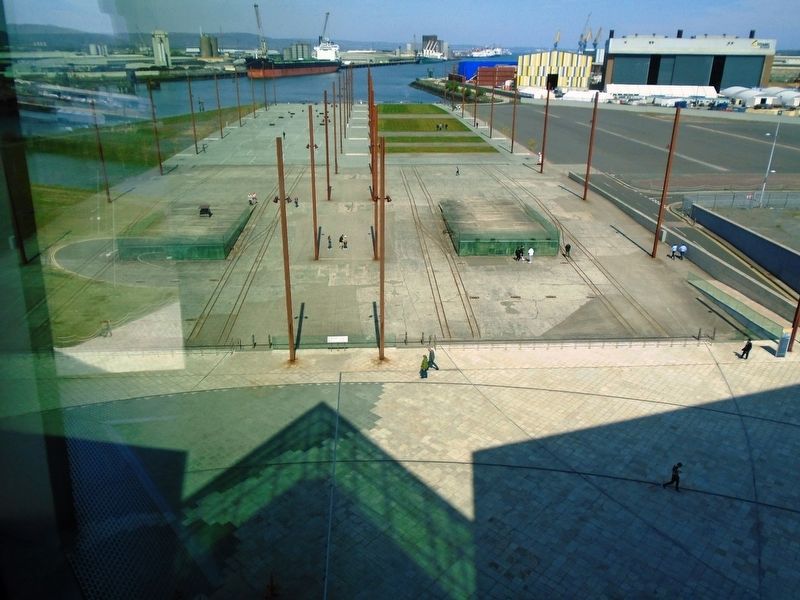Olympic Slipway
Titanic Quarter
— Launched 1910 • Dismantled 1935 —
[Front]
The Olympic Slipway is where RMS Olympic was built beside her sister ship, Titanic. Although quiet and peaceful today, in 1910 this entire area was a hive of human industry, reverberating to the deafening din from steel plates being hammered and riveted and from the belching of mighty steam cranes at the Harland and Wolff shipyard.
The massive Arrol Gantry stood like a geometric spider's web around the shapely hulls of Olympic and Titanic on Slips Nos. 2 and 3. This gantry, measuring 840 ft. long and 270 ft. wide and reaching up to 228 ft. at its tallest point, had been constructed by Sir William Arrol and Company of Glasgow. The keel of the Olympic was laid in Slip No. 2 on 16 December 1908, and up to 4,000 men were involved in her construction.
The Harland and Wolff yard had eight slips at this time, all capable of taking large vessels. The Olympic was the first of a trio of Olympic-class vessels built for the White Star Line by Harland and Wolff. She was followed by the famed Titanic, and a third ship, originally to be called Gigantic, but eventually named Britannic. Ships Nos. 2 and 3 were specially laid for the construction of these new White Star liners, and the huge weight of their hulls meant the slips had to be strengthened with reinforced concrete up to 4.6 ft. thick.
The Olympic was launched on
October 20, 1910 to great excitement, in the presence of the Lord Lieutenant of Ireland and the Countess of Aberdeen. The launch proceedings were specially arranged by Lord Pirrie, the Chairman of Harland and Wolff. With a launch weight of 24,600 tons, a large amount of lubrication was required to set her in motion and it is recorded that 15 tons of tallow, 5 tons of tallow and train oil, mixed, and 3 tons of soft soap were deployed for this purpose.At the time of launch, the ship was an empty shell and work continued after launch to complete her fit and finish. While being fitted out, great emphasis was placed on luxury. She was fitted with a swimming pool (one of the first on a transatlantic liner), a Turkish bath, eleven different styles of decor for first class cabins, and lush greenery in the Palm Court. Her forward grand staircase was a work of great beauty.
The Olympic was completed by the end of May 1911, the fitting out having been finished in just over seven months from the date of launch. This was a remarkable achievement, considering that the company was also completing five other vessels at that time, as well as preparing for the launch of Titanic. At the time of the liners' construction, about 14,000 men worked at Harland and Wolff's Belfast yard. They worked a forty-nine hour week, with only half an hour for lunch and received about £2 per week. They had
one week's holiday in the summer, plus two days at Christmas, and two at Easter.[Back]
On completion, Olympic weighed 45,342 tons and was 852.5 ft. in length. She measured 92.5 ft. in width and her steam triple expansion engines, geared to three screw propellers, produced a top speed of 21 knots. On June 14, 1911, the Olympic left Southampton on her maiden voyage, under the command of Captain Edward John Smith (who was later transferred onto the Titanic for her maiden voyage). On her fifth sailing out of Southampton, Olympic sustained damage in a collision with the Royal Navy Cruiser, HMS Hawke, and returned to Belfast for repairs, which delayed the launch of Titanic.
Later, at the outbreak of the First World War, Olympic was called into service as a troop carrier. It was during this time that she was nicknamed "The Old Reliable," for her good and trustworthy service on these trooping voyages. On May 12, 1918, enemy submarine U-103 attempted to torpedo the liner and missed, but the Olympic turned on her attacker and rammed the submarine, sinking it.
After the war Olympic was converted back to a passenger liner and remained popular throughout the 1920s. But in 1934 the White Star Line merged with the Cunard Line and a number of ships, including the Olympic, was retired. She was finally sold to Metal Industries Limited, and in 1935, she was sent to Jarrow to be scrapped.
Her dismantling took two years and was completed at Inverkeithing in Scotland.Olympic was the flaghip of the three sister vessels. She was the first born, the most special, and Harland and Wolff were justifiably proud of her. Her fame was only eclipsed by the tragic sinking of her younger sister, Titanic. The Britannic, commandeered for use during the First World War, sank in the Aegean after striking a mine and never saw service as a passenger vessel with the White Star Line.
The longest serving commander of RMS Olympic, Sir Bertram Hayes, summed her up well: "The finest ship in my estimation that has ever been built, or ever will be".
Erected by the City of Belfast.
Topics. This historical marker is listed in these topic lists: Industry & Commerce • Man-Made Features • Waterways & Vessels. A significant historical date for this entry is December 16, 1908.
Location. 54° 36.513′ N, 5° 54.547′ W. Marker is in Belfast, Northern Ireland. Marker and slipway are adjacent to the Titanic Belfast museum. Touch for map. Marker is at or near this postal address: 1 Olympic Way, Queen's Road, Belfast, Northern Ireland BT3 9EP, United Kingdom. Touch for directions.
Other nearby markers. At least 8 other markers are within walking distance of this marker. Shipbuilding & Mapmaking [Part 1] (a few steps from this marker); Titanic and Olympic Slipways (within shouting distance of this marker); RMS Titanic Keel Laying Centenary
Also see . . .
1. Titanic Belfast. (Submitted on June 4, 2019, by William Fischer, Jr. of Scranton, Pennsylvania.)
2. Harland and Wolff at Wikipedia. (Submitted on June 4, 2019, by William Fischer, Jr. of Scranton, Pennsylvania.)
3. Visit Belfast. (Submitted on June 5, 2019, by William Fischer, Jr. of Scranton, Pennsylvania.)
Credits. This page was last revised on June 5, 2019. It was originally submitted on June 4, 2019, by William Fischer, Jr. of Scranton, Pennsylvania. This page has been viewed 381 times since then and 74 times this year. Photos: 1. submitted on June 4, 2019, by William Fischer, Jr. of Scranton, Pennsylvania. 2. submitted on June 5, 2019, by William Fischer, Jr. of Scranton, Pennsylvania. 3, 4. submitted on June 4, 2019, by William Fischer, Jr. of Scranton, Pennsylvania.



